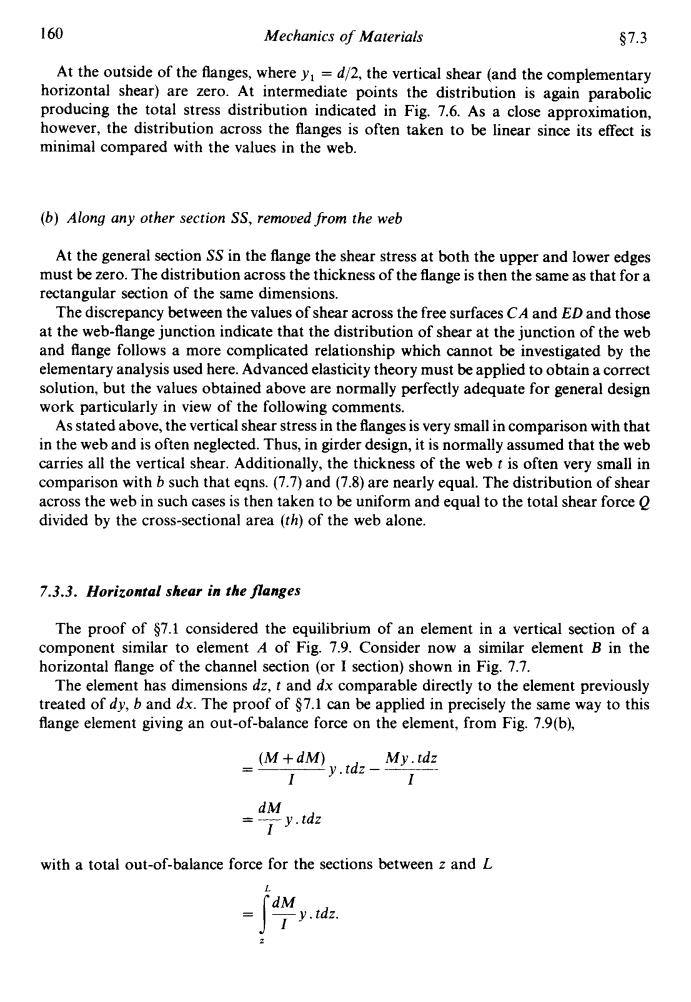正在加载图片...

160 Mechanics of Materials §7.3 At the outside of the flanges,where y=d/2,the vertical shear(and the complementary horizontal shear)are zero.At intermediate points the distribution is again parabolic producing the total stress distribution indicated in Fig.7.6.As a close approximation, however,the distribution across the flanges is often taken to be linear since its effect is minimal compared with the values in the web. (b)Along any other section SS,removed from the web At the general section SS in the flange the shear stress at both the upper and lower edges must be zero.The distribution across the thickness of the flange is then the same as that for a rectangular section of the same dimensions. The discrepancy between the values of shear across the free surfaces CA and ED and those at the web-flange junction indicate that the distribution of shear at the junction of the web and flange follows a more complicated relationship which cannot be investigated by the elementary analysis used here.Advanced elasticity theory must be applied to obtain a correct solution,but the values obtained above are normally perfectly adequate for general design work particularly in view of the following comments. As stated above,the vertical shear stress in the flanges is very small in comparison with that in the web and is often neglected.Thus,in girder design,it is normally assumed that the web carries all the vertical shear.Additionally,the thickness of the web t is often very small in comparison with b such that eqns.(7.7)and (7.8)are nearly equal.The distribution of shear across the web in such cases is then taken to be uniform and equal to the total shear force O divided by the cross-sectional area (th)of the web alone. 7.3.3.Horizontal shear in the flanges The proof of $7.1 considered the equilibrium of an element in a vertical section of a component similar to element A of Fig.7.9.Consider now a similar element B in the horizontal flange of the channel section (or I section)shown in Fig.7.7. The element has dimensions dz,t and dx comparable directly to the element previously treated of dy,b and dx.The proof of $7.1 can be applied in precisely the same way to this flange element giving an out-of-balance force on the element,from Fig.7.9(b), (M+dM)y.tdMy.td 1 dM Iy.tdz with a total out-of-balance force for the sections between z and L y.tdz.160 Mechanics of Materials $7.3 At the outside of the flanges, where y, = d/2, the vertical shear (and the complementary horizontal shear) are zero. At intermediate points the distribution is again parabolic producing the total stress distribution indicated in Fig. 7.6. As a close approximation, however, the distribution across the flanges is often taken to be linear since its effect is minimal compared with the values in the web. (b) Along any other section SS, removed from the web At the general section SS in the flange the shear stress at both the upper and lower edges must be zero. The distribution across the thickness of the flange is then the same as that for a rectangular section of the same dimensions. The discrepancy between the values of shear across the free surfaces CA and ED and those at the web-flange junction indicate that the distribution of shear at the junction of the web and flange follows a more complicated relationship which cannot be investigated by the elementary analysis used here. Advanced elasticity theory must be applied to obtain a correct solution, but the values obtained above are normally perfectly adequate for general design work particularly in view of the following comments. As stated above, the vertical shear stress in the flanges is very small in comparison with that in the web and is often neglected. Thus, in girder design, it is normally assumed that the web carries all the vertical shear. Additionally, the thickness of the web t is often very small in comparison with b such that eqns. (7.7) and (7.8) are nearly equal. The distribution of shear across the web in such cases is then taken to be uniform and equal to the total shear force Q divided by the cross-sectional area (th) of the web alone. 7.3.3. Horizontal shear in the flanges The proof of $7.1 considered the equilibrium of an element in a vertical section of a component similar to element A of Fig. 7.9. Consider now a similar element E in the horizontal flange of the channel section (or I section) shown in Fig. 7.7. The element has dimensions dz, t and dx comparable directly to the element previously treated of dy, b and dx. The proof of $7.1 can be applied in precisely the same way to this flange element giving an out-of-balance force on the element, from Fig. 7.9(b), My. tdz y.tdz---- - (M + dM) - I I dM I = -y.tdz with a total out-of-balance force for the sections between z and L